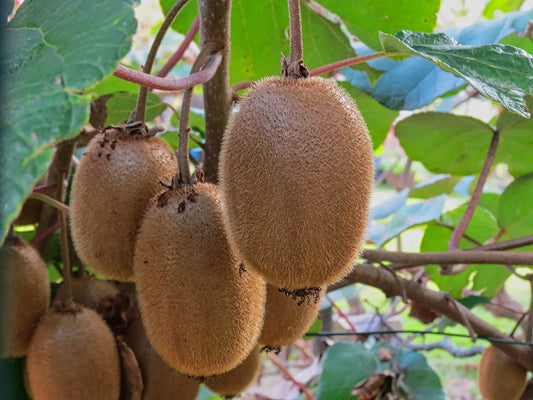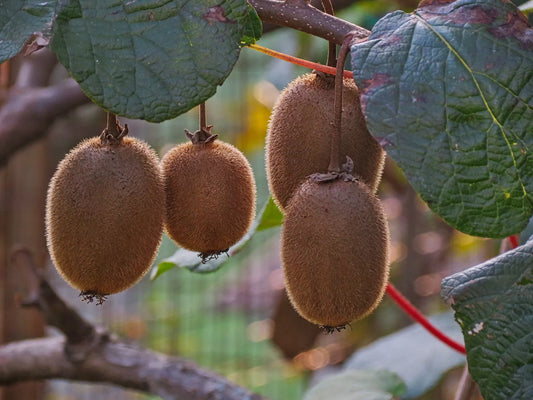-
Delivery from 10 plants to France, Switzerland and Europe
-
Kiwi Plants Wholesale Supplier
-
Quality Kiwi Plants
-
Secure payment - 3X payment
Our Bare Root Kiwi Plants
-
Hayward Kiwi Plant - 1 Year Bare Root Diameter 8+ Conventional
Regular price €8,00 EURRegular price -
Kiwi Tomuri plant - bare-root 1 year old diameter 8+ conventional
Regular price €8,00 EURRegular price -
Hayward Kiwi Plant - 1 Year Old Bare Roots Diameter 10+ Conventional
Regular price €9,00 EURRegular price -
Kiwi Tomuri plant - bare-root 1 year old diameter 10+ conventional
Regular price €9,00 EURRegular price -
Hayward Kiwi Plant - 1 Year Bare Root Diameter 12+ Conventional
Regular price €9,40 EURRegular price -
Kiwi Tomuri plant - bare-root 1 year old diameter 12+ conventional
Regular price €9,40 EURRegular price -
Hayward Kiwi grafted onto Bounty 71 - 1 year old conventional bare-root
Regular price €11,00 EURRegular price -
Hayward Kiwi Grafted on Roki - 1 Year Old Conventional Bare Root
Regular price €11,00 EURRegular price -
Tomuri kiwi grafted on Bounty 71 - 1 year old conventional bare-root
Regular price €11,00 EURRegular price -
Tomuri kiwi grafted onto Roki - 1 year old conventional bare-root
Regular price €11,00 EURRegular price
Collapsible content
When to Plant? When to Harvest? - Growing Guide / Diseases / Pests
You can find all our planting advice for kiwis in France here.
How profitable is kiwi production in France?
Planting / Harvesting Calendar:
Kiwi Planting and Harvesting Calendar
Production schedule for a one-hectare plot of kiwi
Self-fertile / Male Female
What is a self-fertile plant? Our self-fertile kiwi plants
What is a Male/Female plant? Our Male/Female Kiwi plants (Dioecious plants)
Kiwi Pollination - How to Promote It?
Free Plants, Grafted Plants, Rootstocks:
Kiwi - Rootstock or Free Plants: How to Choose?
Kiwi Rootstock Comparison: Bounty 71 vs Roki
Kiwi Grafting Techniques for Professionals
Plot layout / Planting technique
T-bar Method: The T-bar Method: A Complete Guide to Planting Kiwis in France
Pergola Method: The Pergola Method: A Complete Guide to Planting Kiwis in France
Fertilization / manuring of kiwi from planting to production
Kiwi Bud Break - Guide to Successful Kiwi Bud Break
Lignification - Optimizing lignification / Heightening of kiwis
Kiwi Pruning - How to Optimize Kiwi Pruning in France for Exceptional Fruit Production
Kiwi Plants In Vitro - Micro Propagation of Kiwi Plants
Kiwi - Thinning Kiwis. Why and When to Do It?
When and how to harvest kiwis?
Irrigation / Antifreeze System
Kiwi Irrigation - Water Needs of Kiwi Farms in Southern France
Antifreeze System - Antifreeze spray for kiwis: an essential solution for professional producers
Diseases that can affect kiwi crops in France
Fighting Kiwi Bacterial Canker: Symptoms, Prevention, and Professional Solutions
Fighting Kiwi Botrytis: Symptoms, Prevention and Professional Solutions
Fighting Kiwi Phytophthora: Symptoms, Prevention and Professional Solutions
Fighting Sooty Leaf and Fly Dropping Disease in Kiwi Crops: Symptoms, Prevention and Professional Solutions
Fighting Kiwi Scab: Symptoms, Prevention and Professional Solutions
Fighting Kiwi Anthracnose: Symptoms, Prevention and Professional Solutions
Fighting Kiwi Chlorosis: Symptoms, Prevention and Professional Solutions
Fighting Phaeomoniella in Kiwis: Symptoms, Prevention and Professional Solutions
Pests that can affect kiwi crops in France
Fighting the Kiwi Brown Stink Bug: Symptoms, Prevention and Professional Solutions
Fighting Kiwi Mealybug: Symptoms, Prevention and Professional Solutions
Fighting the Voracious Kiwi Mealybug: Symptoms, Prevention and Professional Solutions
Fighting the Kiwi Leafhopper: Symptoms, Prevention and Professional Solutions
Fighting Kiwi Thrips: Symptoms, Prevention and Professional Solutions
Controlling Root Knot Nematodes in Kiwi: Symptoms, Prevention and Professional Solutions
Collection: Our Bare Root Kiwi Plants
At Kiwiverse, we offer high-quality bare-root kiwi plants, an economical and practical solution for both amateur gardeners and kiwi professionals. These plants, easy to transport and plant, allow you to quickly start an orchard or diversify a farm while benefiting from excellent value for money. Discover all the secrets of bare-root plants and how to get the most out of them.
What is a Bare Root Kiwi Plant?
A bare-root kiwi plant is a young plant sold without soil around its roots. It is removed from the ground during its dormant period, usually between November and March, and shipped ready to be planted. This format has several advantages:
- Economy: Bare-root plants are often less expensive than potted plants.
- Easy transport: Their lightness simplifies their handling and reduces shipping costs.
- Adaptability: These plants adapt more easily to their new environment because they develop their roots directly in the native soil.
Why Plant During Dormancy?
The ideal time to plant bare-root kiwi plants is from November to March, when the plants are dormant. During this phase, the plant is less vulnerable to stress and establishes more easily, ensuring better recovery and healthy growth in spring.
Preparing Plants Before Planting
To maximize your chances of success, careful preparation of the plants and soil is essential. Here are the steps to follow:
- Prune the roots: Lightly trim the ends of the roots to stimulate growth.
- Praline the roots: Soak them in clay mud (praline) to prevent drying out and improve their contact with the soil.
- Prepare a planting hole: Dig a hole about 40 cm deep and in diameter, large enough to accommodate the roots without bending them.
Planting Steps
- Position the plant: Place it in the hole, ensuring that the graft point remains 2 to 5 cm above ground level.
- Fill the hole: Fill with the extracted soil, tamping lightly to eliminate air pockets.
- Water generously: Water abundantly to hydrate the roots well and encourage their anchoring.
Benefits of Bare Root Kiwi Plants
- Economy: Bare-root plants are more affordable than potted plants, which helps reduce investment costs, especially for large plantations.
- Increased adaptability: By developing their roots directly in the native soil, these plants become more resistant and better adapted to their environment.
- Ease of transport: Without soil or pots, the plants are light and easy to handle, which simplifies their storage and shipping.
Essential Care After Planting
- Regular watering: The roots of newly planted plants must remain well hydrated. Water regularly, especially during the first few weeks and during dry periods.
- Installing a support: Kiwis are climbing plants. Prepare a trellis, stake, or wire to guide their growth and optimize their development.
-
Mulching: Apply a layer of organic mulch around the base of the plant to:
- Keep moisture,
- Reduce weed competition,
- Improve soil quality.
Key Points for Successful Bare-Root Planting
- Well-drained soil: Kiwis do not tolerate waterlogged soil. If your soil is clayey or poorly drained, add gravel or sand to improve drainage.
- Pollination: Most kiwi varieties require one male plant to pollinate multiple female plants. If you're looking for an alternative, opt for self-fertile varieties.
- Spacing: Allow 3 to 4.5 meters between each plant to allow good air circulation and prevent disease.
Why Choose Kiwiverse Bare Root Plants?
- Certified quality: Our plants are carefully checked to guarantee their vigor and recovery.
- Competitive prices: Thanks to our position as a specialized wholesaler, we offer attractive prices, particularly for large orders.
- Expert support: We offer personalized advice to ensure the success of your plantings.
- Fast delivery: Our bare-root plants are delivered throughout France within 15 days.
FAQ
- What are the benefits of bare-root kiwi plants?
- They are economical, easy to transport and develop a more robust root system in their new environment.
- When should you plant bare-root kiwis?
- The ideal period is between November and March, during the dormancy of the plants.
- Can you plant just one kiwi?
- For most varieties, a male plant is required for pollination. However, self-fertile varieties such as the 'Issai' kiwi can be planted alone.
- What type of soil is suitable for kiwi plants?
- Kiwifruit prefer well-drained soil that is rich in organic matter and slightly acidic to neutral (pH 6 to 6.5).
- Do you need a stand for kiwis?
- Yes, a trellis, stake or pergola is essential to guide the growth of vines.
Conclusion
Bare-root kiwi plants are an ideal solution for gardeners looking to grow these tasty fruit vines at a lower cost. By following the proper planting steps and care, you can ensure rapid recovery and vigorous growth.
Order your bare-root kiwi plants today from Kiwiverse, your specialist kiwi plant wholesaler, and take advantage of our competitive prices to make your growing project a success!


